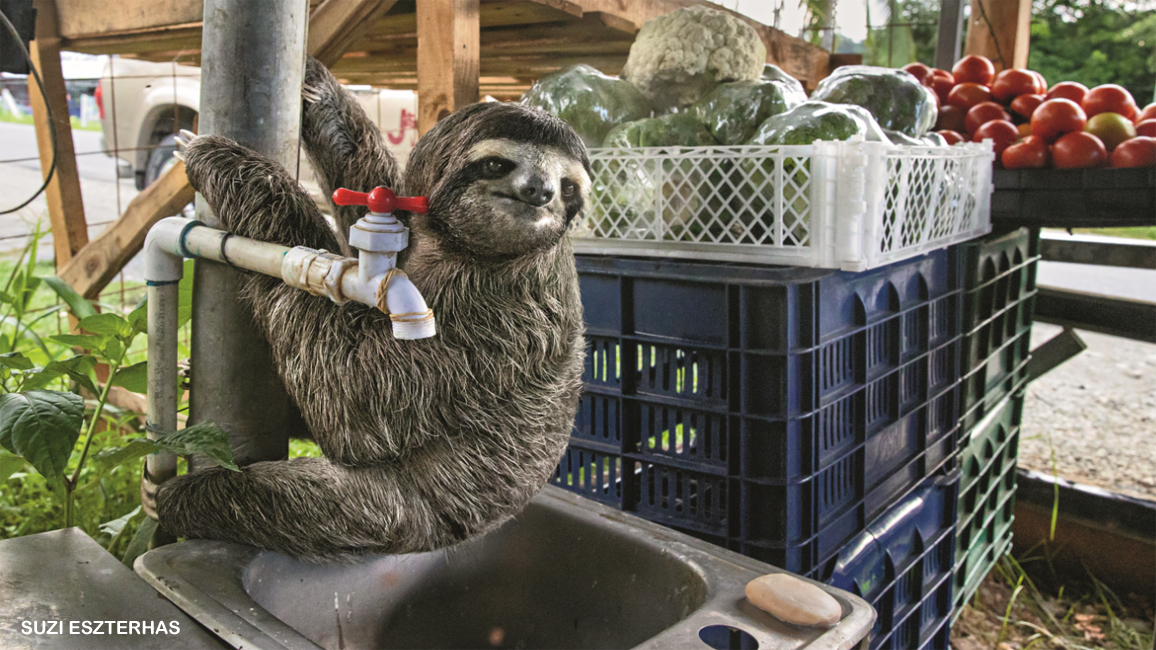
Sloth Town
By Anne Cissel; Photos by Suzi EszterhasSloths belong in the rainforest. But when trees are cut down, these slow, gentle creatures can find themselves in big trouble.
The town of Puerto Viejo (PWAIR-toh vee-EH-ho) de Talamanca in Costa Rica has beautiful beaches, big surfing waves, and plenty of tourists from all around the world. It also has another kind of visitor: sloths. Sloths are happiest hanging out in tropical rainforests. But people cut down trees to make way for roads, houses, and hotels. This forces sloths to enter towns and cities to look for new places to “hang out.” They dangle from electrical lines, cross busy streets, and face off with dogs.
Let’s find out how one scientist and her team are coming to the rescue of the “town sloths.”

IN THE SLOW LANE

All six species of sloths live in Central and South America, and they all move the same way: sloooooowly. It can take a whole minute for a sloth to climb six feet up a tree. Many other animals can do this in a couple of seconds. But being slow in the rainforest is smart! Predators such as jaguars and eagles look for movement when they hunt. Sloths are so still that their enemies rarely notice them.

Sloths have another way to hide, too. Plant-like algae (ALjee) grow on their hair, turning it green. That helps the sloths blend in with the forest. Moving slowly also means sloths don’t use much energy. Since they don’t need a lot of food to power them, they don have to spend much time looking for their next meal.
All these tricks help sloths survive in the rainforest. But in a town, dangers lurk everywhere. For example, in Puerto Viejo de Talamanca, sloths travel from place to place on power lines since there aren’t enough tall trees. Sadly, sometimes they are electrocuted. Also, people charge tourists money to take selfies with baby sloths. Often, those babies have been taken from their mothers. And if sloths can’t find places to climb, they walk slowly on the ground. There, they risk getting hit by cars or attacked by dogs.

But there’s hope for town sloths. Rebecca “Becky” Cliffe, founder of the Sloth Conservation Foundation, works with a team every day to get sloths back to the forest where they belong.
HELP FOR SLOTHS

Becky and her team do many things to help sloths. When trees are cut down, gaps are left between the remaining trees. The team installs rope bridges between trees to connect them. That way, sloths can move between the trees and find more food to eat. The team also works to get power lines covered with a material that protects sloths from getting shocked.
Becky also has organized a group of “sloth helpers” throughout Puerto Viejo de Talamanca. Business owners teach tourists how to avoid bothering sloths. (Keep 10 feet away!) They also keep the trees on their land healthy so sloths have places to live. And they call Becky when a sloth looks as if it’s in trouble and needs to be rescued. When Becky arrives, she carefully removes the sloth from the dangerous situation and puts it in a carrier.

The rescued sloths get released back into a nearby forest. But some of them are first fitted with “sloth backpacks.” The backpacks have electronic transmitters inside to help scientists keep track of the sloths as they move around. There is a lot that scientists don’t know about these animals. The more they know, the more they can help them.
But trees are still coming down, and buildings are going up in their place. There’s only one way to help these slow animals: by moving fast to protect their forests!


















